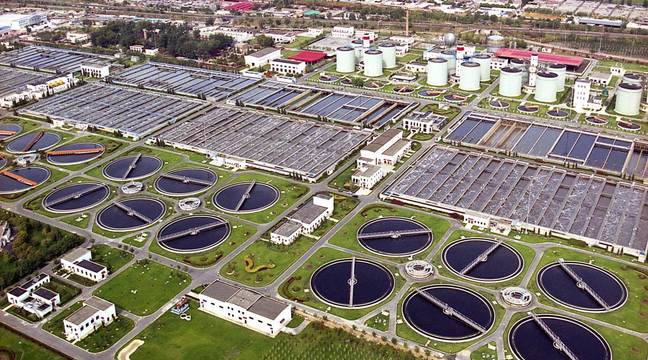
当前课程知识点:Water and Wastewater Treatment Engineering: Biochemical Technology > Chapter 4 Other aerobic biological wastewater treatment process > Section 4.2 A-B process > Section 4.2 A-B process
返回《Water and Wastewater Treatment Engineering: Biochemical Technology》慕课在线视频课程列表
返回《Water and Wastewater Treatment Engineering: Biochemical Technology》慕课在线视频列表
同学们好,我们下面来学第二节A–B法工艺
A–B法工艺实际上是指吸附-生物降解工艺
吸附是Adsorption,生物降解是Biodegradation
A–B法工艺,首先是由德国亚琛工业大学的
Bohnke教授在上个世纪70年代中期开发出来的
后期在世界各地、在中国,都得到了广泛的应用
这节主要介绍三个内容
第一个是AB法的工艺原理及工艺流程
第二个是AB法的工艺特征
第三是AB法的主要设计参数
我们这给出的是AB法的工艺流程,我们可以看到
这个工艺流程跟我们前面讲的活性污泥法工艺、
氧化沟工艺等都有很大的差别,它由两段组成,A段和B段
而A段和B段都是一个完整的活性污泥法的工艺
都由一个生物反应器和一个二沉池来组成
在A段中间的生物反应器我们称为吸附池
它主要是发挥细菌对废水中的有机物的吸附功能
然后进入二沉池,沉淀分离
污泥回流,剩余污泥排放,通过中间的沉淀池
沉淀后的出水再进入B段,在B段里面
我们把它称为一个曝气池或者是生物反应池
废水进入B段,B段的生物反应池就是一个常规的曝气池
在曝气池中间发挥活性污泥对废水中间有机物或者其他污染物的降解
去除和转化的功能,随后进入二沉池,进行泥水分离,部分污泥回流
部分污泥作为剩余污泥排放,而出水就是整个工艺的一个出水
在前面有一个特点是,废水需要经过格栅和沉砂池的处理
但是特别强调,在AB法工艺中间不需要增加初沉池
实际上是,初沉池被改造成了吸附池
但是又跟简单的改造不一样的是,在吸附池的后面增加了一个中间沉淀池
所以这就是AB法的一个工艺流程
我们也从这个流程上能够明显的看出
它跟普通的一级的活性污泥工艺相比有明显的差别
所以AB法的主要工艺特征是
第一它没有设置初沉池,它由吸附池和中间沉淀池组成
A段称为一级处理系统,B段由曝气池和二沉池组成
A,B两段各自拥有独立的污泥回流系统
两段从生物学上是完全分开,各自有独特的微生物的群体
有利于发挥各自的功能。我们具体来看一下
作为A段它的特征,首先
A段是不设初沉池,所以原废水中间微生物全部能够进入吸附池
所以,A段是一个开放性的生物反应器
它所接纳的是已经适应了原废水这种恶劣条件下的所有的微生物
A段第二个特点是负荷很高
它有利于增殖速度快,适应能力强的微生物在其中生长
它对BOD5的去除效果比较差
一般只有40%-70%,但是出水的可生化性相对有所提高
有利于后续B段的继续降解,而在A段中间污泥的产率非常高
细菌的吸附能力也非常强
它对有机物的去除以吸附作用为主,生物降解只占30%左右
对于B段,它的来水是A段的出水
所以相对来说水质、水量都比较稳定
B段所承受的负荷率为总的负荷率的30%-60%
B段的污泥龄较长,有利于硝化反应
第三点来介绍一下AB法的主要设计参数
对于A段来说它的污泥负荷率比较高
通常可以在2.0-6.0kgBOD5/(kgMLSS·d)
水力停留时间非常短,一般在30分钟左右
污泥龄也非常短,在0.3-0.5天,其中的溶解氧控制的比较低
我们一般控制在0.2-0.7mg/l左右,而对于B段来说
它的污泥负荷率跟常规的活性污泥法差不多
是在0.15-0.3kgBOD5/(kgMLSS·d),水力停留时间2.0-3.0小时
这当然是指处理城市生活污水的条件下
污泥龄可以在15-20天
其中的溶解氧控制在1.0-2.0mg/l左右
这一节的内容就介绍到这,谢谢
-Section 0.1 Development Status of Wastewater Treatment Process
--Section 0.1 Development Status of Wastewater Treatment Process
-Section 0.2 Typical Processes of Wastewater Biological Treatment
--Section 0.2 Typical Processes of Wastewater Biological Treatment
-Section 1.1 Principles of wastewater aerobic biological treatment
--1.1 Principles of wastewater aerobic biological treatment
-Section 1.2 Principles and determination of wastewater biodegradability
--1.2 Principles and determination of wastewater biodegradability
-Section 1.3 Principles of wastewater anaerobic biological treatment
--Section 1.3.1 Principles of wastewater anaerobic biological treatment(1)
--Section 1.3.2 Principles of wastewater anaerobic biological treatment(2)
-Section 1.4 Principles of wastewater biological nitrogen removal
--Section 1.4 Principles of wastewater biological nitrogen removal
-Section 1.5 Principles of wastewater biological phosphorus removal
--Section 1.5 Principles of wastewater biological phosphorus removal
-Chapter 1 Homework
-Section 2.1 Basic concept of activated sludge process
--Section 2.1.1 Basic concept of activated sludge process
--Section 2.1.2 Basic concept of activated sludge process
-Section 2.2 Growth rule of activated sludge and its application
--Section 2.2 Growth rule of activated sludge and its application
-Section 2.3 Running mode of activated sludge process
--Section 2.3.1 Running mode of activated sludge process(1)
--Section 2.3.2 Running mode of activated sludge process(2)
-Section 2.4 Kinetics of active sludge process
--Section 2.4.1 Kinetics of active sludge process(1)
--Section 2.4.2 Kinetics of active sludge process(2)
--Section 2.4.3 Kinetics of active sludge process(3)
--Research and Development of Kinetic Model of Activated Sludge Process
-Section 2.5 Principle, calculation and equipment of aeration
--Section 2.5.1 Principle, calculation and equipment of aeration(1)
--Section 2.5.2 Principle, calculation and equipment of aeration(2)
-Section 2.6 Designing of activated sludge process
--Section 2.6 Designing of activated sludge process
-Section 2.7 Operation and management of active sludge process
--Section 2.7.1 Operation and management of active sludge process (1)
--Section 2.7.2 Operation and management of active sludge process (2)
-Chapter 2 Homework
-Section 3.1 Basic principle of biofilm
--Section 3.1 Basic principle of biofilm
-Section 3.2 Biofilter process
--Section 3.2.1 Biofilter Process (1)
--Section 3.2.2 Biofilter process (2)
--Section 3.2.3 Biofilter process (3)
-Section 3.3 Biodisk process
-Section 3.4 Biological contact oxidation process
--Section 3.4 Biological contact oxidation process
-Section 3.5 Aerobic biological fluidized bed process
--Section 3.5 Aerobic biological fluidized bed process
-Chapter 3 Homework
-Section 4.1 Oxidation ditch process
--Section 4.1 Oxidation ditch process
-Section 4.2 A-B process
-Section 4.3 SBR process
-Section 4.4 MBR process
-Chapter 4 Homework
-Section 5.1 Overview and characteristics of development of anaerobic biological treatment
--Section 5.1 Overview and characteristics of development of anaerobic biological treatment
-Section 5.2 Anaerobic digester
--Section 5.2 Anaerobic digester
-Section 5.3 Anaerobic contact process and anaerobic filter process
--Section 5.3 Anaerobic contact process and anaerobic filter process
-Section 5.4 UASB process
-Section 5.5 Other anaerobic biological treatment process
--Section 5.5 Other anaerobic biological treatment process
-Section 5.6 Operation management of anaerobic biological treatment process
--Section 5.6 Operation management of anaerobic biological treatment process
-Chapter 5 Homework
-Section 6.1 Introduction
-Section 6.2 Biological nitrogen removal process and technology
--Section 6.2 Biological nitrogen removal process and technology
-Section 6.3 Biological phosphorus removal process and technology
--Section 6.3 Biological phosphorus removal process and technology
-Section 6.4 Simultaneous nitrogen and phosphorus removal process
--Section 6.4 Simultaneous nitrogen and phosphorus removal process
-Chapter 6 Homework
-Section 7 Natural biological treatment process
--Section 7 Natural biological treatment process
-Chapter 7 Homework
-Section 8.1 Source, nature and treatment of sludge
--Section 8.1 Source, nature and treatment of sludge
-Section 8.2 Sludge thickening and digestive stability
--Section 8.2 Sludge thickening and digestive stability
-Section 8.3 Sludge conditioning, dehydration and incineration
--Section 8.3 Sludge conditioning, dehydration and incineration
-Chapter 8 Homework
-Section 9 Wastewater Discharge and Reuse
--Section 9 Wastewater Discharge and Reuse
-Chapter 9 Homework
